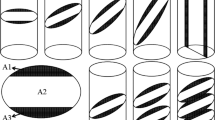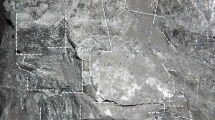Abstract
Fissures in natural rocks play an important role in determining the strength, deformability and failure behavior of rock mass. However in the past, triaxial compression experiments have rarely been conducted for rock materials containing three-dimensional (3-D) fissures and the failure mechanical behavior of fissured rocks is not well known due to the difficulty of conducting triaxial experiments on fissured rocks. Therefore in this research, conventional triaxial compression experiments were performed to study the strength, deformability and failure behavior of granite specimens with one preexisting open fissure. Thirty-one specimens were prepared to perform conventional triaxial compression tests for intact and fissured granite. First, based on the experimental results, the effects of the confining pressure and the fissure angle on the elastic modulus and the peak axial strain of granite specimens are analyzed. Second, the influence of the confining pressure on the crack damage threshold and the peak strength of granite with respect to various fissure angles are evaluated. For the same fissure angle, the crack damage threshold and the peak strength of granite both increase with the confining pressure, which is in good agreement with the linear Mohr–Coulomb criterion. With increasing fissure angle, the cohesion of granite first increases and later decreases, but the internal friction angle is not obviously dependent on the fissure angle. Third, nine crack types are identified to analyze the failure characteristics of granite specimens containing a single fissure under conventional triaxial compression. Finally, a series of X-ray microcomputed tomography (CT) observations were conducted to analyze the internal damage mechanism of granite specimens with respect to various fissure angles. Reconstructed 3-D CT images indicate obvious effects of confining pressure and fissure angle on the crack system of granite specimens. The study helps to elucidate the fundamental nature of rock failure under conventional triaxial compression.





















Similar content being viewed by others
References
Chen L, Liu JF, Wang CP, Liu J, Su R, Wang J (2014) Characterization of damage evolution in granite under compressive stress condition and its effect on permeability. Int J Rock Mech Min Sci 71:340–349
Fairhurst CE, Hudson JA (1999) Draft ISRM suggested method for the complete stress–strain curve for the intact rock in uniaxial compression. Int J Rock Mech Min Sci 36(3):279–289
Fan QX, Zhu HB, Geng J (2015) Monitoring result analysis of high slope of five-step ship lock in the Three Gorges Project. J Rock Mech Geotech Eng 7:199–206
Fujii Y, Ishijima Y (2004) Consideration of fracture growth from an inclined slit and inclined initial fracture at the surface of rock and mortar in compression. Int J Rock Mech Min Sci 41:1035–1041
Heap MJ, Baud P, Meredith PG, Bell AF, Main IG (2009) Time-dependent brittle creep in Darley Dale sandstone. J Geophys Res. doi:10.1029/2008JB006212
Jia L, Chen M, Zhang W, Xu T, Zhou Y, Hou B, Jin Y (2013) Experimental study and numerical modeling of brittle fracture of carbonate rock under uniaxial compression. Mech Res Commun 50(4):58–62
Lee H, Jeon S (2011) An experimental and numerical study of fracture coalescence in pre-cracked specimens under uniaxial compression. Int J Solids Struct 48(6):979–999
Li YP, Chen LZ, Wang YH (2005) Experimental research on pre-cracked marble under compression. Int J Solids Struct 42(9/10):2505–2516
Lu ZD, Ding WX, Feng XT, Zhang YL (2008) Experimental study on mechanical-hydraulic-chemical coupling process in cracked rocks. Chin J Rock Mech Eng 27(4):796–804 (in Chinese)
Lu Y, Wang L, Elsworth D (2015) Uniaxial strength and failure in sandstone containing a pre-existing 3-D surface flaw. Int J Fract 194(1):59–79
Park CH, Bobet A (2009) Crack coalescence in specimens with open and closed flaws: a comparison. Int J Rock Mech Min Sci 46(5):819–829
Prudencio M, Van Sint Jan M (2007) Strength and failure modes of rock mass models with non-persistent joints. Int J Rock Mech Min Sci 44(6):890–902
Shi AC (2006) Study on performance and method of feedback design in high rock slope engineering. Hohai University, Nanjing
Sun Q, Zhang W, Xue L, Zhang Z, Su T (2015) Thermal damage pattern and thresholds of granite. Environ Earth Sci 74(3):2341–2349
Wang Y, Li X, Wu YF, Lin C, Zhang B (2015) Experimental study on meso-damage cracking characteristics of RSA by CT test. Environ Earth Sci 73(9):5545–5558
Wong RHC, Chau KT (1998) Crack coalescence in a rock-like material containing two cracks. Int J Rock Mech Min Sci 35(2):147–164
Wong LNY, Einstein HH (2009) Systematic evaluation of cracking behavior in specimens containing single flaws under uniaxial compression. Int J Rock Mech Min Sci 46(2):239–249
Wong TF, David C, Zhu W (1997) The transition from brittle faulting to cataclastic flow in porous sandstones. Mech Deformat J Geophys Res 102(B2):3009–3025
Yang SQ, Jing HW (2011) Strength failure and crack coalescence behavior of brittle sandstone samples containing a single fissure under uniaxial compression. Int J Fract 168(2):227–250
Yang SQ, Jiang YZ, Xu WY, Chen XQ (2008) Experimental investigation on strength and failure behavior of pre-cracked marble under conventional triaxial compression. Int J Solids Struct 45(17):4796–4819
Yang SQ, Yang DS, Jing HW, Li YH, Wang SY (2012a) An experimental study of the fracture coalescence behaviour of brittle sandstone specimens containing three fissures. Rock Mech Rock Eng 45(4):563–582
Yang SQ, Jing HW, Wang SY (2012b) Experimental investigation on the strength, deformability, failure behavior and acoustic emission locations of red sandstone under triaxial compression. Rock Mech Rock Eng 45(4):583–606
Yang Y, Ju Y, Sun Y, Zhang D (2015) Numerical study of the stress field during crack growth in porous rocks. Geomech Geophys Geo-Energy Geo-Resour 1(3):91–101
Yang SQ, Ranjith PG, Jing HW, Tian WL, Ju Y (2017) An experimental investigation on thermal damage and failure mechanical behavior of granite after exposure to different high temperature treatments. Geothermics 65:180–197
Yu Y, Yin JM (2004) Energy dissipation properties of three gorges granite under different loading modes. Chin J Rock Mech Eng 23(2):205–208 (in Chinese)
Zhang XP, Wong LNY (2012) Cracking processes in rock-like material containing a single flaw under uniaxial compression: a numerical study based on parallel bonded-particle model approach. Rock Mech Rock Eng 45:711–737
Zhao XG, Cai M, Wang J, Ma LK (2013) Damage stress and acoustic emission characteristics of the Beishan granite. Int J Rock Mech Min Sci 64:258–269
Zhao GF, Russell AR, Zhao X, Khalili N (2014) Strain rate dependency of uniaxial tensile strength in gosford sandstone by the distinct lattice spring model with x-ray micro CT. Int J Solids Struct 51:1587–1600
Zhao YS, Wan ZJ, Feng ZJ, Xu ZH, Liang WG (2017) Evolution of mechanical properties of granite at high temperature and high pressure. DOI, Geomech Geophys Geo-Energy Geo-Resour. doi:10.1007/s40948-017-0052-8
Zhu ZQ, Sheng Q, Leng XL, Zhang ZR (2007) Study on crack initiation mechanism of three gorges granite. Chin J Rock Mech Eng 26(12):2570–2575 (in Chinese)
Acknowledgements
This research was supported by the Fundamental Research Funds for the Central Universities (2015XKZD05). We would also like to acknowledge the editor and the anonymous reviewers for their valuable comments, which have greatly improved this paper.
Author information
Authors and Affiliations
Corresponding author
Rights and permissions
About this article
Cite this article
Yang, SQ., Huang, YH. An experimental study on deformation and failure mechanical behavior of granite containing a single fissure under different confining pressures. Environ Earth Sci 76, 364 (2017). https://doi.org/10.1007/s12665-017-6696-4
Received:
Accepted:
Published:
DOI: https://doi.org/10.1007/s12665-017-6696-4





